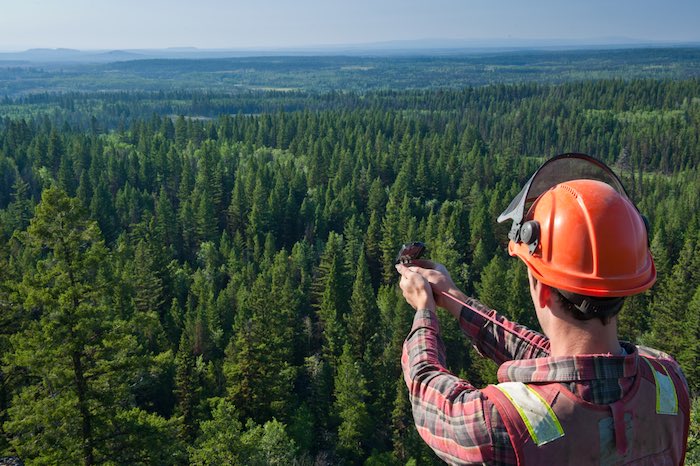Business
Canada’s Forest Sector Responds to Misleading Report

The legacy media is widely distributing an article outlining a report released by the Natural Resources Defense Council claiming Canada’s forestry sector emits even more carbon than Alberta’s oilsands. Not wishing to undergo the same vilification as the oil sector, the Forest Products Association of Canada is quickly countering the report with this article.
Article Submitted by the Forest Products Association of Canada
Earlier today, the Natural Resources Defense Council (NRDC) and Nature Canada jointly released a misleading and damaging report on Canada’s GHG emissions. Derek Nighbor, President and CEO, Forest Products Association of Canada (FPAC) issued the following statement in response:
Last week, economists from the Royal Bank of Canada confirmed their expectation that Canada will enter a recession in the first quarter of 2023. This presents unique challenges for working families in rural and northern Canada where economic prospects are often limited to a few key industries like agriculture, energy, mining, and forestry.
In hundreds of these communities across the country – from Prince George, BC to Corner Brook, NL – the forest sector is a central economic driver and provides jobs to over 200,000 Canadians. Beyond its economic contributions, Canadian forestry is known globally for its responsible harvest practices, high quality products, and its ability to help build a lower carbon economy. Canadian foresters also play an essential role in mitigating growing fire risks, protecting carbon rich wetlands, building with renewable, carbon-storing wood products, and creating environmentally friendly products from what would otherwise be wood waste.
Nordic countries show us how boreal forests can be managed to maximize carbon storage, even in a warming climate. Although their forests are much smaller, Finland and Sweden harvest six to eight times the timber volume per forested hectare than Canada does. At the same time, the net annual increase in stored carbon in Sweden’s forest is so large it reduces national GHG emissions by 70%. These Nordic governments have done something that Canada has not. In developing their climate plans, these leaders have worked with key industries like forestry to build sector-specific plans to maximize environmental and economic outcomes.
While we were disappointed to see another misleading report on forestry issued by the US-based Natural Resources Defense Council (NRDC) and Nature Canada, we were not surprised. Both NRDC and Nature Canada fundraise on their anti-Canadian forestry campaign rhetoric.
It’s worth noting that staff in NRDC’s New York, Washington, and San Francisco offices suggest they care about Canada’s forests and Canadian workers, even as they actively lobby multiple US states to encourage state legislators to restrict Canadian forest products coming into those states. For reasons that are difficult to understand, Nature Canada has chosen to be a willing partner.
Let’s be clear. Canada has a forest carbon problem that is caused by the worsening natural disturbance patterns we are seeing through drought, pest outbreaks, and catastrophic wildland fire. It’s a growing problem impacting forest health and resiliency, human health and community safety, and we urgently need constructive solutions – not deliberately misleading attacks.
FPAC continues to call on the federal government to follow the Nordic examples and work with our sector to develop a comprehensive plan for Canadian forestry, even as we contribute to the federal National Adaptation Strategy (NAS), which is a key deliverable and discussion matter at the upcoming COP 27 global climate conference next month in Sharm El Sheikh, Egypt.
Canadian forestry needs an NAS that minimizes climate-driven disturbance by actively reducing disturbance risk and supporting forest operations that maximize long-term carbon storage performance. This means increased timber harvests that value carbon and forest health – and the creation of new markets for low-grade wood fibre, including via thinning and residual biomass. It also means more forestry – not less. Forestry that will accelerate economic reconciliation with Indigenous communities, keep communities safer from fire risks, support biodiversity conservation and important ecosystem values, and provide good-paying jobs and careers in the rural and northern Canadian communities that desperately need them.
Business
Canada’s critical minerals are key to negotiating with Trump

From Resource Works
The United States wants to break its reliance on China for minerals, giving Canada a distinct advantage.
Trade issues were top of mind when United States President Donald Trump landed in Kananaskis, Alberta, for the G7 Summit. As he was met by Prime Minister Mark Carney, Canada’s vast supply of critical minerals loomed large over a potential trade deal between North America’s two largest countries.
Although Trump’s appearance at the G7 Summit was cut short by the outbreak of open hostilities between Iran and Israel, the occasion still marked a turning point in commercial and economic relations between Canada and the U.S. Whether they worsen or improve remains to be seen, but given Trump’s strategy of breaking American dependence on China for critical minerals, Canada is in a favourable position.
Despite the president’s early exit, he and Prime Minister Carney signed an accord that pledged to strike a Canada-US trade deal within 30 days.
Canada’s minerals are a natural advantage during trade talks due to the rise in worldwide demand for them. Without the minerals that Canada can produce and export, it is impossible to power modern industries like defence, renewable energy, and electric vehicles (EV).
Nickel, gallium, germanium, cobalt, graphite, and tungsten can all be found in Canada, and the U.S. will need them to maintain its leadership in the fields of technology and economics.
The fallout from Trump’s tough talk on tariff policy and his musings about annexing Canada have only increased the importance of mineral security. The president’s plan extends beyond the economy and is vital for his strategy of protecting American geopolitical interests.
Currently, the U.S. remains dependent on China for rare earth minerals, and this is a major handicap due to their rivalry with Beijing. Canada has been named as a key partner and ally in addressing that strategic gap.
Canada currently holds 34 critical minerals, offering a crucial potential advantage to the U.S. and a strategic alternative to the near-monopoly currently held by the Chinese. The Ring of Fire, a vast region of northern Ontario, is a treasure trove of critical minerals and has long been discussed as a future powerhouse of Canadian mining.
Ontario’s provincial government is spearheading the region’s development and is moving fast with legislation intended to speed up and streamline that process. In Ottawa, there is agreement between the Liberal government and Conservative opposition that the Ring of Fire needs to be developed to bolster the Canadian economy and national trade strategies.
Whether Canada comes away from the negotiations with the US in a stronger or weaker place will depend on the federal government’s willingness to make hard choices. One of those will be ramping up development, which can just as easily excite local communities as it can upset them.
One of the great drags on the Canadian economy over the past decade has been the inability to finish projects in a timely manner, especially in the natural resource sector. There was no good reason for the Trans Mountain pipeline expansion to take over a decade to complete, and for new mines to still take nearly twice that amount of time to be completed.
Canada is already an energy powerhouse and can very easily turn itself into a superpower in that sector. With that should come the ambition to unlock our mineral potential to complement that. Whether it be energy, water, uranium, or minerals, Canada has everything it needs to become the democratic world’s supplier of choice in the modern economy.
Given that world trade is in flux and its future is uncertain, it is better for Canada to enter that future from a place of strength, not weakness. There is no other choice.
Business
Rhetoric—not evidence—continues to dominate climate debate and policy

From the Fraser Institute
Myths, fallacies and ideological rhetoric continue to dominate the climate policy discussion, leading to costly and ineffective government policies,
according to a new study published today by the Fraser Institute, an independent, nonpartisan Canadian public policy think-tank.
“When considering climate policies, it’s important to understand what the science and analysis actually show instead of what the climate alarmists believe to be true,” said Kenneth P. Green, Fraser Institute senior fellow and author of Four Climate Fallacies.
The study dispels several myths about climate change and popular—but ineffective—emission reduction policies, specifically:
• Capitalism causes climate change: In fact, according to several environment/climate indices and the Fraser Institute’s annual Economic Freedom of the World Index, the more economically free a country is, the more effective it is at protecting its environment and combatting climate change.
• Even small-emitting countries can do their part to fight climate change: Even if Canada reduced its greenhouse gas emissions to zero, there would be
little to no measurable impact in global emissions, and it distracts people from the main drivers of emissions, which are China, India and the developing
world.
• Vehicle electrification will reduce climate risk and clean the air: Research has shown that while EVs can reduce GHG emissions when powered with
low-GHG energy, they often are not, and further, have offsetting environmental harms, reducing net environmental/climate benefits.
• Carbon capture and storage is a viable strategy to combat climate change: While effective at a small scale, the benefits of carbon capture and
storage to reduce global greenhouse gas emissions on a massive scale are limited and questionable.
“Citizens and their governments around the world need to be guided by scientific evidence when it comes to what climate policies make the most sense,” Green said.
“Unfortunately, the climate policy debate is too often dominated by myths, fallacies and false claims by activists and alarmists, with costly and ineffective results.”

Kenneth P. Green
Senior Fellow, Fraser Institute
-

 Alberta1 day ago
Alberta1 day agoAlberta health care blockbuster: Province eliminating AHS Health Zones in favour of local decision-making!
-

 Crime2 days ago
Crime2 days agoUK finally admits clear evidence linking Pakistanis and child grooming gangs
-

 conflict1 day ago
conflict1 day agoTrump: ‘We’ have control over Iranian airspace; know where Khomeini is hiding
-

 Alberta19 hours ago
Alberta19 hours agoAlberta pro-life group says health officials admit many babies are left to die after failed abortions
-

 Alberta18 hours ago
Alberta18 hours agoCentral Alberta MP resigns to give Conservative leader Pierre Poilievre a chance to regain a seat in Parliament
-

 Business2 days ago
Business2 days agoCarney praises Trump’s world ‘leadership’ at G7 meeting in Canada
-

 Daily Caller19 hours ago
Daily Caller19 hours ago‘Not Held Hostage Anymore’: Economist Explains How America Benefits If Trump Gets Oil And Gas Expansion
-

 Alberta12 hours ago
Alberta12 hours agoCalls for a new pipeline to the coast are only getting louder

